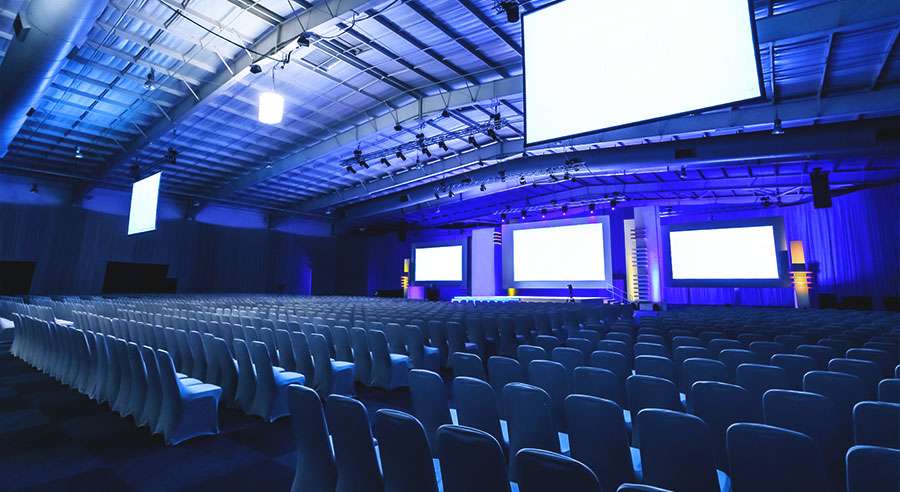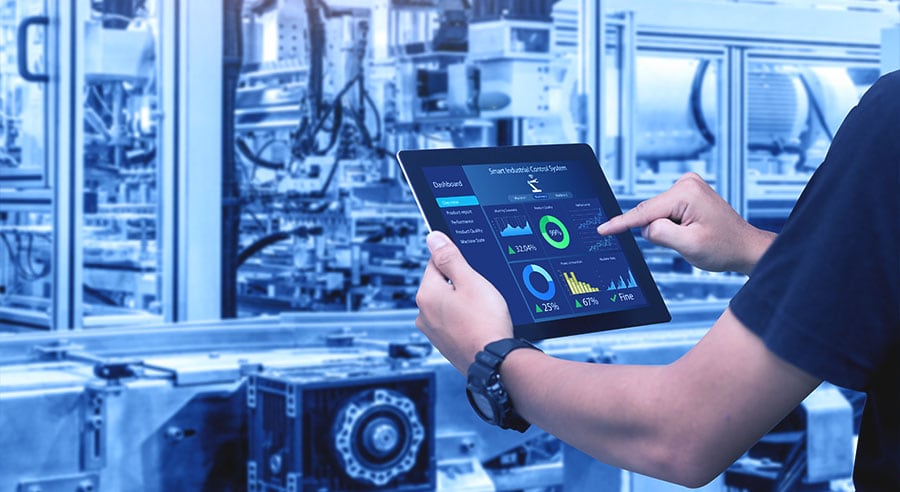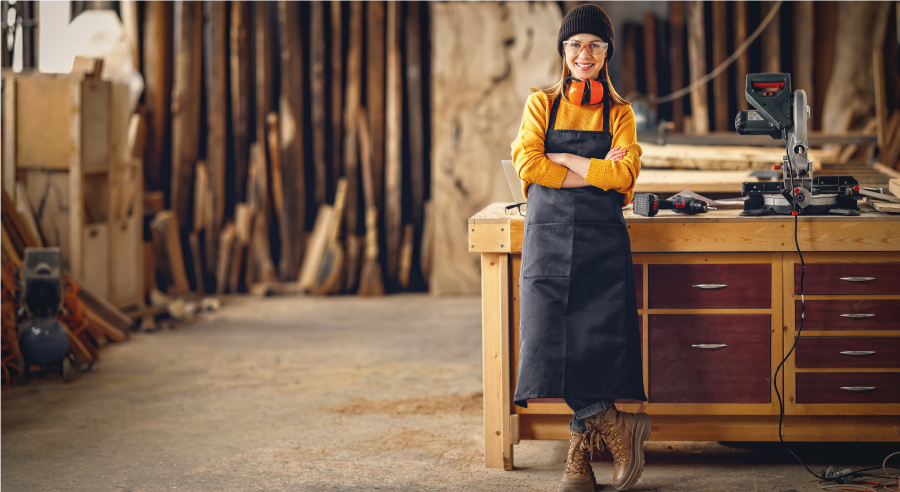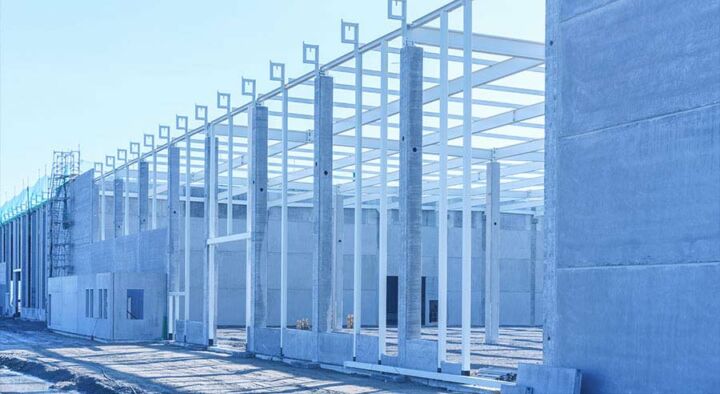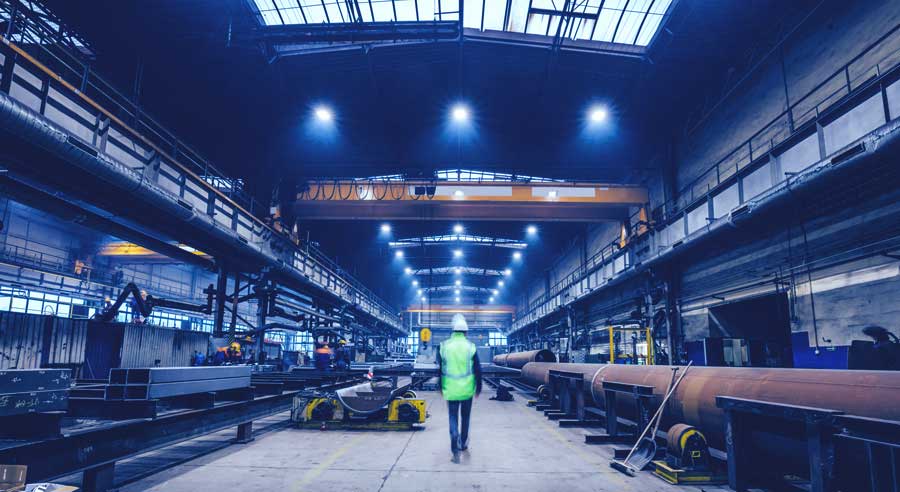Space heaters - Solutions for event and exhibition halls
Whether concert fan, art lover or party enthusiast: the room temperature also determines the success of events. How hosts ensure a feel-good climate with hall heaters in event halls and exhibition rooms.
Concerts, art exhibitions and corporate events are increasingly taking place in unusual locations - for example in old fish factories, heating plants or in tents on historic factory sites. The ambience: often a mixture of rustic and modern. An atmosphere that only unfolds, however, when the temperature is right. After all, who likes drinking Chardonnay with cold feet? Or eat a salmon appetizer with a hypothermic nose?
That's right, no one. And that's why most event organizers strive for a comfortable feel-good temperature. They are experimenting with various heating solutions. For example, with mobile warm-air heaters that blow heated air into tents via warm-air hoses. Or with mushroom heaters, near which guests warm themselves with a gas flame.
The problem: Many hosts are not really satisfied with warm air systems as hall heaters.
Because warm air has a mind of its own. It distributes itself unevenly in halls and tents, mixes with cold layers of air, creates a draft on the legs, arms and necks of the guests. "Honey, do you think we might want to leave so slowly?", this sentence is then uttered far too early in the evening at worst. Not the only shortcoming.
The electricity bill is also often unnecessarily high. This is because warm air flees toward the ceiling - in other words, where it is of no use to anyone and only causes energy costs. Implementing different temperature zones, such as a cool zone at the buffet and a warmer one in the lounge areas? Virtually impossible with air that is constantly mixing. Last but not least, many warm air systems as hall heaters look less chic, more like relics from the 1980s. They often cannot be integrated into a modern environment without a visual break. And in the worst case, they are so loud with their humming and hissing that they disturb the ambience.
Targeted and economical heating: infrared heaters reshuffle the cards
For hosts for whom warm air systems are not enough because they are too loud and unattractive, eat up too much energy and do not even satisfy many guests, there is an alternative solution: Infrared heaters. The hall heaters reshuffle the cards when it comes to heating event halls and exhibition spaces. Why?
Because their principle of operation is fundamentally different from warm air systems. For example, infrared systems do not heat the air. Instead, they generate electromagnetic waves that convert into heat as soon as they hit solid bodies - such as guests or tables, benches and stages. The advantage: hosts no longer have to heat all the air in a hall or large tent to create a comfortable temperature, but can focus specifically on the area of use. Since this is usually many times smaller, you save a massive amount of energy. But that's not all.
Bringing the pleasure of pleasant sun rays indoors
Do you know it? You go for a walk on an autumn day. The air is pleasantly cool, but at the same time you feel the warm rays of the sun on your skin. A feel-good atmosphere that infrared heaters also create indoors. Guests find the infrared heat particularly pleasant because it corresponds to the natural heat principle of the sun - without dry heating air, dust swirls and drafts.
Also the eye does not come too briefly. Modern infrared heaters can be discreetly integrated into the surroundings or highlighted as a design element in their own right. In addition, the hall heaters operate as quiet as a whisper and would not even disturb Ludwig von Beethoven's 15th string quartet. They are therefore perfect for tempering large tents, event halls and exhibition rooms.
Hamburg fish auction hall pampers guests with infrared heat
Do you know the fish auction hall at the St. Pauli fish market? It is a magnet for night owls and tourists from all over the world. That's because every Sunday, starting at dawn, visitors come here to buy fish rolls and other delicacies from hundreds of food stalls and food trucks. They enjoy eating and drinking in merry gatherings on beer benches in the fish hall - with live music until twelve o'clock at night. An inviting setting that is also appreciated by organizers of cinema festivals, theater and reading days, and the multi-day Light Festival. Events are regularly held in the 4,100 m2 hall, with up to 4,200 people.
And the temperature in the fish auction hall is always right. That's because the operators have installed OPTIMA series infrared radiant heaters, painted to match the style of the architecture and suspended from specially designed, invisible wire cables. The units warm the 103-meter-long and 23-meter-wide hall, which is eleven meters high at the dome, with a total output of 700 kW. The heat from the hall heaters is concentrated specifically on the area of use, i.e. on tables, benches, food stands and, of course, the guests themselves.
The thousands of cubic meters of air above this area, on the other hand, are cool without disturbing anyone. The visitors' ears are also spared any annoying noise. KÜBLER supplied the radiant heaters in super-silent design and additionally soundproofed the exhaust fans. Thus, the noise effect is reduced from industry standard almost to concert level.
Fish auction hall saves 50,000 euros in heating costs per year
But the operators of the fish auction hall not only benefit from a modern, inconspicuous appearance and quiet operation of the hall heaters. OPTIMA also reduces energy consumption in the fish auction hall - by up to 50 percent compared to conventional systems. Even more energy can be saved with the R.O.S.S.Y digital control system, as heaters can be controlled with pinpoint accuracy and preheating times can be reduced to an environmentally compatible minimum in line with weather periods and seasons.
The bottom line is a heating cost saving of 50,000 euros per year. And extrapolated over the life cycle, a saving of 19,830 MWh of primary energy. Enough power to heat around 700 average households for a year.
KÜBLER infrared heaters are also used in the Tresor, a disused heating plant in Berlin's Mitte district. Now on six levels, connected by staircases and mezzanines with numerous rooms and niches, there is over 20,000 m2 of exhibition and event space for contemporary music, art and culture. Space that needs to be heated. For this purpose, the operators initially planned a warm-air heating system. But it quickly became clear that too much energy would be lost due to the expected thermals in the direction of the roof.
The alternative: 20 black-painted infrared heaters from the OPTIMA series. The radiators, however, are only part of the heating solution. A heat exchanger called O.P.U.S. X also plays a role. It makes it possible to use the residual heat from the infrared radiators in the H.Y.B.R.I.D. system to heat water, for example. The operator of the vault recovers up to 15 percent of the energy that was previously lost to the environment in this way.
How digitalisation is changing the heat supply in industry and commerce
We live in a time of rapid change. Digitalisation is increasingly determining our everyday working lives. For companies that want to be successful and competitive in the future, there is no way around it. When we talk about Industry 4.0, this is exactly what we mean: Machines and industrial processes are intelligently networked and controlled by algorithms. Many industrial companies have already implemented this or are on their way. But while the main focus is on production processes, other areas, such as heat supply, are usually overlooked. Rightly so?
The fact is, that a digital heat supply can unleash great savings potential - especially in the industrial sector, where enormous amounts of energy, financial resources but also manpower are used for heating. Potential that could benefit companies and the environment: through significantly lower costs and measurably reduced emissions. At KÜBLER we call this digital progress "HEAT 4.0". Let's take a look at what digital industrial heating looks like in a moment. First, however, let's clarify the question: What new technical possibilities does the digitalisation of heat supply - especially hall heating - bring?
Digital drives the heat supply at an optimal efficiency level
As a rule, heating systems in factories and warehouses are switched on at the beginning of the heating period and switched off again at the end. In between, very little usually happens. Between us: very few companies find the time to regularly check whether the heating time is too long, the heating temperature too high or the night setback not regulated at all. The same applies to hall heating as to cars: the way the car is driven determines the energy consumption. So the better adapted to the usage requirements, the more efficient the heating operation. Smart digital control systems can take care of this - they steer the heat supply through the winter with significantly less energy consumption, but at an optimal temperature level.
Intelligent tools manage the heating process and enable a completely new transparency
These digital controls permanently record data in real-time monitoring. This creates unprecedented transparency about the heating process. If you want to know which devices are active, how much energy they consume and when, whether the settings and efficiency values of your heat supply are still correct - now it is possible. In addition, the digital data is permanently analysed and documented and is available to you, for example, for your internal quality management or for ISO 50001 or 14001 audits.
Digital integration increases the availability of your heating system
The interplay of digitalised industrial heating systems and control systems thus offers completely new possibilities in heat supply. This also includes predictive maintenance. Long before your hall heating system possibly malfunctions, you can see what is happening in the burner at the control centre or on the monitor. You could have many interventions carried out directly online, without a service technician having to go on the way. This would not only save an enormous amount of time and distance, but also increase the availability of your heat supply - and thus the safety of your production processes.
Speaking of production: Imagine what would happen if the heating in production failed. Employee satisfaction and motivation will suffer - and in the worst case, production will come to a standstill for the time being. How about taking a completely new look at the heat supply from this perspective? Not as a "distant memory", but as an important component of your machinery? This also makes sense from an economic point of view, because today the heat supply should be subject to the same cost-benefit consideration as any of your production machines. But back to the topic of Industry 4.0 and heat supply. Because in addition to the digitalisation of your industrial heating, this also includes networking.
Networked, new savings potentials can be exploited
Industrial heating systems are no longer isolated solutions. They are networked with other technologies and even network the various energy flows in the building. For example, residual heat can be used to generate hot water and use it in sanitary rooms or to support hydraulic office heating. Waste heat from the production process can be integrated into the systems just as much as energy from solar thermal energy and, and, and ... Building management systems or various software tools can be integrated and monitor, for example, the opening times of hall doors. And all this is controlled across locations, regardless of the PC workstation.
Digitising the heat supply improves energy efficiency and reduces costs
However, the digitalisation of hall heating systems not only offers you completely new technical possibilities. It also helps you to identify and exploit potential savings in heat supply. The reduction of energy consumption through extremely efficient infrared heating technologies and optimised operation alone can result in savings in primary energy consumption of up to 70 percent. These are dimensions that pay off significantly in business terms in view of the high consumption in industrial companies - with annual cost savings of up to six figures, depending on the company, at relatively low investment costs. Incidentally, it is also interesting to know this: Legislation also rewards the high contribution to CO2 reduction and climate protection. In the Building Energy law, the heat supply with decentralised systems (such as gas infrared heaters) in new buildings with a room height of more than four metres is exempted from the obligation to use regenerative energies.
New and economically very interesting services are only made possible by digital heat supply
You should get to know a new - and perhaps the most interesting - aspect of digitalisation at this point: the heat supply can be rented. After all, the new, digital possibilities are particularly helpful when companies find themselves in the situation: Modern energy-saving heating technology? "Yes" - budget? "No".
Many companies shy away from the investment and the associated depreciation expense. And that is understandable - especially in economically uncertain times. If the old heating system is still running halfway - why not save on the new investment? The digital age also offers a solution for this, which can be extremely interesting for companies: The digitalisation of heat supply enables completely flexible and very affordable rental concepts such as HeizWerk.
With this rental concept, we assume responsibility for the heating process. From the energy refurbishment to the operation. Via intelligent remote maintenance software, we have a permanent overview of the heating processes and efficiency of the system and control it at an optimal level according to the usage profile. The company itself only rents the heat - without the associated investment and depreciation requirements. At the end of the year, companies with such a rental solution therefore even have money "left over". This is because the energy cost savings are usually higher than the rental amount. Tackling the digitalisation of the heat supply is therefore also worthwhile in financial terms - and makes this sustainable and economically sensible decision palatable for every company.
It is becoming clear: digitalisation is fundamentally changing the heat supply
It can support companies in mastering the greatest challenges in heating halls - always with an eye to the future. Digitised heating and software tools grant more process transparency, increase energy efficiency, increase availability and reduce heating costs at the same time. And in a time when flexibility is also playing an increasingly important role, digital solutions are indispensable anyway. Only with their help can rental concepts be offered that enable a heat supply without any capital expenditure.
Would you now like to exploit these possibilities in your company? Then please feel free to contact us! Together we will find a solution that fits your requirements exactly.
WORKSHOP HEATING - WHAT YOU SHOULD LOOK OUT FOR WHEN MAKING YOUR CHOICE
Whether in locksmith shops, carpentry shops, welding shops, car dealerships or railroad companies - workshop heating systems ensure warm working conditions in the workshops when it gets cold outside. But what requirements - apart from heat generation, of course - can you place on a modern heating system today? And what do you have to pay attention to if you want your investment to continue to pay off for you in many years to come?
First things first: the right workshop heating should fit your requirements.
If you search for workshop heating in search engines, you will get a variety of technologies mentioned. Fan heaters, cannons, electric heaters and radiant floor heaters are among them, as well as infrared heaters. However, before you take a closer look at the technologies, you should first be clear about your requirements. The following questions can help you with this:
Building
- What is the height, length and width of the hall building?
- What is the insulation condition?
- What is the hall atmosphere like (e.g. dusty, damp, drafty)?
- How many windows and doors does the hall have?
- Are there any adjoining office rooms?
Utilization profile
- How is the hall used?
- At what times - are there work shifts?
- Are there different usage zones?
Energy sources
- What energy sources are available?
Other requirements
- What goals do you want to achieve with the heating system?
- Economic efficiency
- High heating comfort
- Flexibility
- Future security
- other?
Once you have answered these questions for yourself, some heating systems may no longer even come into question and the choice becomes more manageable for you. In any case, you can give your heating engineer a clear profile of requirements, which he can use to recommend the right heating system for your workshop.
Bring a clean and draft-free working environment into the workshop
Especially in dust-intensive work, such as often occurs in carpentry shops, you should make sure that your new workshop heating system does not also contribute to additional air pollution. But clean air and a draft-free indoor climate are also important in other workshop operations, if only to ensure that your employees feel comfortable and can work productively. So you should opt for a system that avoids drafts that could stir up dust. This is where infrared heaters of the dark radiator type have proven particularly successful, because they heat - similar to the natural heating principle of the sun - through infrared rays and not through heated air. And they have another decisive advantage for a good indoor climate, because they have a direct exhaust duct, i.e. the waste heat is conducted to the outside in a controlled manner without polluting the hall atmosphere.
Look for high energy efficiency in workshop heating - then the environment & your bank account benefit
Particularly in the heating sector, legislation is placing increasingly stringent requirements on the technologies used. But it is certainly also important to you personally to keep the expensive use of resources as low as possible. Therefore, pay special attention to the consumption values of your new workshop heating system. Over the life cycle, high energy consumption not only costs the environment dearly, it is also an unnecessary burden on your budget. Infrared systems specially developed for workshop heating generally consume 30 - 40 % less than conventional warm air systems. However, these factors also make a decisive contribution to the cost-effectiveness of the heating system in your workshop:
- precise design of the heating system to suit the usage profile (see above)
- controlled direct exhaust gas routing
- the integration of other energies such as residual heat
- good and transparent control
Benefit from the possibilities of intelligent control systems
Today, modern heating systems can be controlled flexibly and according to demand. For example, you can define production areas and storage areas in the workshop as different heating zones and heat them individually. You can use dark radiators to keep the temperature of storage areas in your hall lower than that of production - which can save a lot of energy costs. Fluctuations in the outside temperature, day and night cycles, additional shifts or holidays can also be mapped with intelligent control systems and the heating operation optimized accordingly. Via the display or PC, you as the user can view the performance and important parameters of the system, such as operating time or energy consumption, at any time. Smart add-on modules automatically ensure that energy is not unnecessarily wasted in the area of open workshop doors. This can be very lucrative, especially in automotive workshops with high air exchange rates. Today, control systems are important for operating workshop heating systems as optimally as possible - they play a decisive role in saving energy, carbon dioxide and energy costs.
Plan for future changes with your workshop heating system
Workshop heating systems are an investment in the future. Provided you have chosen a quality product. Then the life cycle can be as long as 20 years. A lot can happen in that time. That's why it's important that your new garage heating system leaves as many options open to you as possible. These include such important points as:
- The flexibility to move, expand or remotely control your heater at any time.
- keeping the ceiling open as much as possible, e.g. for cranes or lighting changes
- Keeping the hall floor as clear as possible, e.g. for changes in machine installation
- Gradually use more renewable energy sources (e.g., green gases) as they become available.
The last point in particular must be well thought out, because a compromise between climate requirements and utilization profile can cost you dearly. Technologies that use only renewable energy are always hot water based and therefore relatively sluggish. If you want your workshop heating to be fast and flexibly controllable, gas-fired infrared heating technologies are recommended. Apart from the fact that they can generally be operated with biogas, methane is also increasingly becoming a green energy source through the addition of hydrogen H2.
Five mistakes you should avoid when planning heating in new hall construction
Are you looking for an economical and future-proof heating system for your new hall construction? Then you should invest enough time in planning. And avoid the following mistakes.
More than ever, a hall heating system influences the profitability and freedom of action of companies. Why? Because energy prices are rising and environmental regulations are becoming stricter. But which heating solution is the most energy-efficient and future-proof? Companies don't have much room for experimentation. Once installed, heating systems generally remain in operation for up to 20 years. All the more important: invest a lot of time in heating planning before making the investment. A phase in which you should avoid the following mistakes.
Mistake No. 1: Treat a hall like an office building
Offices are usually well-insulated rooms with low ceiling height. Their volume is almost identical to the useful zone. Therefore, it is not a waste of energy to heat the entire room. However, the situation is quite different with industrial and commercial halls. Anyone who approaches this with the heating approach for multi-story buildings is giving away heat and money. This is because it is usually quite sufficient for the working area to be warm. As a rule, the lower two meters of the hall are warm - in the case of a hall with a ceiling height of ten meters, only 20 percent of the room volume. Or even just the part where people are working.
With such a targeted heating approach, the principle applies: the smaller the ratio between the usable area and the total volume, the more decisive is the quality of heat transfer. Infrared heaters achieve a high quality in this respect. Instead of heating the air per se, the decentralized heaters generate electromagnetic waves that are converted into heat only as soon as they encounter solid bodies. In combination with intelligent controls, energy savings of up to 70 percent can be achieved compared to conventional heating systems. This is a significant factor, as it can be assumed that energy will become more expensive in the coming years.
Mistake No. 2: Usage profile and requirements are not specified.
Just install a heater and turn it on until it's halfway warm everywhere? This is how companies have wasted energy for decades. A waste that can become a competitive disadvantage in times of rising energy prices. That's why you should think in advance about the features of your new hall: Where exactly in the hall do employees need heat, where can it stay cooler? How much air exchange takes place in the hall and when? How much waste heat do machines and systems already produce? How can this be used intelligently?
If you know these parameters, specify requirements and create a detailed usage profile, a responsive heating system with an intelligent control system can adapt to the hall's needs like a tailor-made suit. And save a lot of energy. After all, the most economical heating system in terms of consumption is the one that the operator does not even have to switch on. Why the name dark radiator is outdated from a technical point of view
Mistake No. 3: Forgoing networking and an intelligent control system when building a new hall.
Intelligent control is a luxury? Networking a superfluous gimmick? No, digitalization is essential for heating halls in an energy-efficient manner and saving enormous amounts of money in the future. Therefore, be sure to check whether the heating system for your new hall construction has arrived in the age of digitalization. Networked devices, modern controls and analysis software make it possible to adapt heating systems to hall dynamics and thus save energy. In addition, hall operators can better meet the requirements of the DIN 50001 standard with software-supported heating systems. With this certification (or a registered environmental management system in accordance with the EMAS regulation), you fulfill the requirements for partial exemption from the EEG apportionment or future relief from electricity and energy tax.
Mistake No. 4: Focusing only on investment costs
Focusing only on initial investment costs for decision making? That can also be a mistake. Because much more important still are the total costs incurred throughout the life cycle of the heating system - costs for service, maintenance and repair included. One particularly interesting part of this total cost of ownership (TCO): consumption costs. Here, you should definitely not let the provider get away with a pi-by-thumb estimate. Nowadays, it is easy to provide detailed and reliable information in accordance with DIN V 18599 - including annual primary energy requirements, energy costs and CO2 emissions. Information that gives you planning and decision-making security.
Mistake No. 5: Not taking a close look at the supplier
On the way to an economical heating system for your new hall construction, you should not only take a close look at the quality of the equipment, but also at the competence of the manufacturer. Research whether the company can provide credible references. Equally important, to be spared long downtimes, be sure to check that the vendor will still be offering service and spare parts supply fifteen years from now. After all, it's annoying if you're on your own when it comes to servicing your shop heating system after just a few years. You can also inquire whether the company has its own research and development department. Such a department - especially in combination with convincing references - is usually a reliable indicator of competence and experience. Two points that are important for finding and operating an economical and future-proof hall heating system.
HEATING FOR HALLS: CHALLENGES AND SOLUTIONS
Room volume, employee needs, climate protection goals, heating costs, and, and, and: When choosing the right heating system for your halls, you need to consider a whole range of factors. Read this article to find out what these are in detail and how you can master these challenges with a modern system.
First challenge in heating for halls: The structural characteristics
The biggest challenge in terms of heating for halls is probably the enormous spatial volume of hall buildings and their ceiling heights of four, ten or more meters. Keeping these buildings at a constant working temperature in winter is anything but trivial. Especially if the energy costs are not to get out of hand.
Added to this is the difficulty that no two industrial or commercial buildings are the same. High racks, overhead cranes, a wide variety of floor plans and usage profiles all place their own demands on the heating system to be installed. Simply distributing a few heaters in the room is not enough here. Due to their size and height, hall buildings have very special requirements in terms of building physics, which differ fundamentally from multi-story buildings. Therefore, it is worthwhile to consult a designated hall heating expert in order not to have to live with compromises in terms of functionality and end up investing a lot of money unnecessarily for insufficient performance.
Not always in view, but a relevant factor in heating for halls: Employee needs and a productive indoor climate
The structural characteristics of hall buildings also make it difficult to influence the indoor climate as desired and thus ensure a good working atmosphere. However, this is an important factor for the productivity of your employees: Ideally, the temperature in the work area should be 18 to 20 °C. But not every employee needs the same temperature. But not every employee needs the same temperatures: those who do physical work would naturally like it cooler than their colleague with a quiet activity while sitting or standing. When it comes to choosing the right heating system for your halls, this poses another challenge, because it means you have to plan for different zones that can be heated flexibly. Both in terms of working areas and in terms of usable zones.
Different hall zones require flexible systems
Let's take a closer look at what everyday life in industrial and commercial halls looks like: In one area of the hall, temperature- and condensation-sensitive goods are stored that must be kept at a uniform temperature. At the other end, a door remains open despite the freezing outside temperature - why close it if it has to be opened again? There is no need to run the heating here. It would be a waste of energy and money. In between, there are the workplaces already mentioned with different temperature requirements.
In addition, there are ceiling cranes that are parked under the heater from time to time and block the heat radiation. Perhaps the heater is also switched off overnight to keep operating costs down - and has to heat up again the next morning just in time for the start of operations. Without long lead times, of course. In view of all these points, it makes little sense to rely on heating systems for halls that continuously heat the air. Flexible systems are needed!
Energy and climate policy comes more into focus
With regard to heating systems for halls, however, it is no longer just what happens inside the hall that counts. What happens outside the building is also becoming increasingly relevant. We are talking here about climate protection and thus energy consumption. By 2030, primary energy consumption in Germany is to be reduced by 30% compared with 2008, and halved by 2050 - that's what the Energy Efficiency Strategy 2050 of the German Federal Ministry for Economic Affairs and Energy says. In the building sector in particular, the Federal Republic wants to drive energy efficiency forward in the process.
For hall owners planning a new heating system, this means the next challenge: It is essential to rely on heating systems that are as efficient as possible and fuels with low emissions in order to reduce energy consumption to a minimum. Ideally, residual heat is also used to really get the most out of heating your halls. Using energy optimally in this way protects the environment and is in line with climate protection targets. Because one thing is clear: less fuel consumption - less emissions. But you should also rely on energy-saving hall heating systems in your own interest. Because:
The question of the right heating system for your halls is closely related to the question of costs
Over their life cycle, hall heating systems consume six to twenty times more energy than the investment costs. This makes the operation of these heating systems significant cost drivers for hall owners, which are difficult to get under control without an efficient, flexible system. Let's take a look back at the aspects that arise from the specifics of the building and the day-to-day work.
Heating the entire room volume: Unnecessary energy consumption. Air heated by hot-air heating systems that accumulates under the ceiling of the hall: unnecessary energy consumption. Heating unused hall zones: Unnecessary energy consumption. Overheated hall areas because heating cannot be flexibly controlled: Unnecessary energy consumption. Heaters that continue to heat even when the hall doors are open: Unnecessary energy consumption. Heaters that have only been heating the overhead crane parked underneath them for hours: Unnecessary energy consumption. Overall, heating that does not match the usage profile of the hall - unnecessary energy consumption.
The list could be continued endlessly, but it has certainly already become clear: Only modern, intelligently operating heating systems that have been specifically developed as heating systems for halls will help you avoid precisely such energy-wasting traps and thus keep both investment and running costs low. And this also with a view to the future. Because heating costs will continue to rise in the coming years. The reason for this is the CO2 tax on the use of fossil fuels, which has been in force in some countries such as Germany since January 1, 2021. It therefore makes sense, on the one hand, to rely on a particularly low-CO2 fuel such as gas and, on the other hand, on a highly efficient heating system for your halls - unless you want to put up with the rising costs.
This makes it clear: There are a whole range of challenges when it comes to selecting heating systems for halls. It's good if you know them and can avoid them in a targeted manner. Thus, in conclusion, the question arises:
What is the solution to these challenges?
As described at the beginning, no two halls are alike. The selection of the right heating system for your halls must therefore also take into account your individual circumstances. There is no blanket solution. In principle, however, you can meet all the challenges mentioned above with a modern, gas-powered infrared radiator system from a ceiling height of four meters. With the help of intelligent control technology and modular extensions, problems such as open hall doors can be detected and the heating in this area can be switched off.
On a zone-by-zone basis, the heater can meet different temperature requirements. Since infrared heaters do not heat the air per se, there is no dust turbulence or unpleasant drafts. Also, no warm air accumulates unused under the hall ceiling. Simply put, such a heating system heats only what is really necessary. In combination with natural gas as a fuel (which has a high primary energy factor and is becoming increasingly green) and intelligent use of residual heat (for example, to heat adjacent offices), you kill all birds with one stone: manageable investment costs. High energy efficiency. Satisfied employees. Low total cost of ownership. Environmental protection. So when choosing a heating system for your halls, go for the right solution right from the start!




